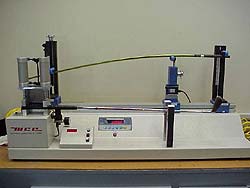Shaft Profile (Trajectory, Spin Rates, Feel)
We test over 2,500 shafts each year and have over 2,000 shafts to choose from in our BGF (Better Golf…Faster) fitting system. Check out our new MyGolfShafts apps to see what shaft may suit YOUR swing. More…
This is probably the least understood yet extremely important aspect of shaft fitting. For years, shaft characteristics have been defined by the bend point, kick point or flex point. All of this has changed. It is now possible to select shafts that have a variety of shaft stiffness; both butt and tip, as well as variable trajectories, low, mid or high. In addition, more advanced shaft materials have allowed us to reduce or increase the spin rate of the ball coming off the club face. And the latest research shows that the relative stiffness of the mid section of the shaft along with shaft torque creates a unique feel for each golfer. Finding the right feel creates more confidence and improved performance.

At D’Lance Golf Performance Center we test 21 different variables on each shaft to determine the consistency and exact characteristics of the shaft. We are using the MCC Shaft Profiler to determine the exact shaft stiffness at both the butt and tip end as well as the stiffest part of the shaft (spine) to determine proper shaft choice and alignment. We also test the overall integrity of the shaft to determine the quality of manufacture. If shafts do not meet our tolerances we simply return them to the manufacturer.
In the chart above, the Project X T1100 and Tensei CK Pro White shafts have a much stiffer mid section than the Graphite Design Tour AD DI 6, or OBAN Isawa Red 65. These shafts are designed for lower launch and spin characteristics and golfers that have a very strong release before impact (high kick velocity), and tend to hit the ball high with a lot of spin. Golfers with a smoother tempo, average launch and spin will have better performance with the Graphite Design Tour AD DI 6. Golfers looking for higher launch and higher spin, which is good for slower ball speeds, will get better performance from the Tensei CK Pro Blue.
The proper trajectory (low, high or mid) as well as the tip stiffness is determined for the individual golfer based upon the results of the True Temper Shaft Lab or Mizuno Shaft Optimzer analysis and dynamic testing for launch angle, spin rates, and ball speed on our launch monitors.
One final aspect of shaft fitting is torque, or the amount of twisting a shaft does when a ball is struck. With the advent of larger clubheads, especially in drivers, torque has become an increasingly important consideration. If you tend to be very erratic in hitting shots off the heel and toe of the club, you will be better off with a higher torque shaft (one that twists MORE at impact). The reason for this is something called the “gear effect”. When you hit a ball off the toe of the club, the clubhead twists and puts sidespin on the ball. This sidespin actually is in the opposite direction to the twisting of the clubhead(just like a gear). This spin will help draw the ball back to the center of the target area. Similarly, heel shots will also impart sidespin that will fade the ball back to the center of the target area. If the torque of the shaft is too stiff, the clubhead will not twist and will not put much sidespin on the ball. This means the shot will go where the clubface was pointing at impact (Open Face – Right of Target, Closed Face – Left of Target). In general, higher handicap players should opt for higher torque shafts while lower handicap players will benefit from lower torque shafts.
One interesting fitting aspect that we have found is using low torque shafts with softer tip sections for players that like the feel of more “kick” in their shots. The lower torque actually helps maintain the stability of the shaft even though the tip section is softer for more release at impact. At D’Lance Golf, we match the golfer’s shaft to their ability and desire to create consistent shots as determined on the Golf Achiever launch monitor.
 |
 |
| MCC Tip Torsional Resistant (TTR) Technology | |
